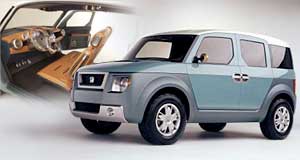Model X marks Honda's spot
BY MARTON PETTENDY | 4th Jan 2002

An official name has yet to be released, however, the new model will have similar features to the Model X concept unveiled at last year's North American International Auto Show in Detroit.
"Model X radically departs from traditional automotive design and thinking in a way that resonates with a younger audience," said Dick Colliver, executive vice president of American Honda.
The exterior design of the Model X has a simple two-box design with side mouldings running the length of the vehicle for a durable look. The side doors are designed without a B-pillar and open from the centre.
Interior features include a flip-up navigation screen with integrated wireless Internet capability, video input and DVD playback. The stereo system includes MP3 download and playback capability, along with satellite radio, cassette and CD player.
A mass-produced version of the Honda Model X is scheduled for release about a year from now.
Honda also unveiled its latest fuel cell vehicle at the LA Auto Show - the FCX-V4.
The FCX-V4 features better driving performance, maximum speed, acceleration and driving distance than the previous FCX-V3. It features an advanced fuel cell power system with a compact drive motor, integrated control systems and seats four people.
All components of the fuel cell unit have been newly designed. There are now two hydrogen fuel tanks - boosting cruising range from 177km to almost 300km.
The FCX-V4 features an advanced fuel cell stack and Honda-developed ultra-capacitor. The FCX-V4 achieves a top speed of 140km/h with an electric motor that has a maximum power output of 60kW and 238Nm of torque.
Responsive acceleration is achieved through the combination of a high-output fuel cell stack with the powerful instantaneous discharge capabilities of the ultra-capacitor. The ultra-capacitor also contributes to high fuel efficiency as it regenerates energy normally lost during braking.